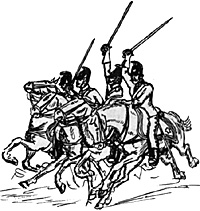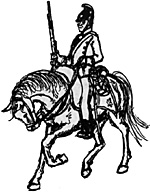 The Hapsburg armies engaged in the Austro-Prussian War of 1866 had, contrary to what one might suppose, a proportion of mounted troops similar to and probably less than those of Prussia.
The Hapsburg armies engaged in the Austro-Prussian War of 1866 had, contrary to what one might suppose, a proportion of mounted troops similar to and probably less than those of Prussia.
Of these cavalry forces 14 were "German-Speaking," or of at least nominally German regimental recruitment. Napoleonic fans will recall that Hussars were of Hungarian Recruitment, Uhlans were of Polish recruitment, and the Cuirassiers, Dragoons, and Chevaulerger were of "German" recruitment. By 1866, however, most of the "German" cavalry regiments were "Cuirassiers," i.e. heavy, but lacked the familiar breastplate, which was dropped in 1860. Only two regiments of Dragoons and none of the Chevauleger remained.
Almost equal in number were each of the other categories, hussar and lancer. The Hussars and Lancers, however, were definitely classed as light cavalry, and many of the regiments were broken up, one squadron accompanying each Brigade of line Infantry, totaling one light cavalry regiment par Austrian Corps dArmse, while even the dragoons, though classed light, were banded in Independent cavalry divisions, one to each brigade of the Division Edolshiem (light reserve cavalry.) These were the main battle cavalry of the army intended to act offensively against enemy troops on the field as shock troops
 At a distance the cuirassier and dragoon regiments look practically identical. By 1866 both wore white costs and baggy hungarian riding trousers (of the pattern called "Lasalle" in the French service) ending in leather false boots and apparently leather lined . Those of the cuirassiers were of blue, with the seam in regimental color while those of the dragoons were probably of grey. Helmets were of a pattern familiar to Napoleonic collectors of Austrian heavy cavalry-leather black reinforced with brass plates and crest.
At a distance the cuirassier and dragoon regiments look practically identical. By 1866 both wore white costs and baggy hungarian riding trousers (of the pattern called "Lasalle" in the French service) ending in leather false boots and apparently leather lined . Those of the cuirassiers were of blue, with the seam in regimental color while those of the dragoons were probably of grey. Helmets were of a pattern familiar to Napoleonic collectors of Austrian heavy cavalry-leather black reinforced with brass plates and crest.
The sabraque, or saddle cloth was normally red trimmed in button color. This was the last war for white coat, fancy shabraque, and, in fact, for the Austrian heavy cavalry. Only German Generals (as opposed to Hungarian Generals who wore a red hussar uniform) retained the white coat after the 1867-68 reforms.
When it came to weaponry, distinctions between Cuirassier and dragoon were maintained. Accounts of Konnigratz abound with mention of the terrible wounds inflicted by the long straight swords of the cuirassiers, while the dragoons are shown by Knotel with the curved style of the light cavalry. while the dragoon traditionally wore the carbine, similar to that of the hussar, the single minded cuirassier, breastplate or no, had only a horse pistol, worn behind the saddle on the right, or "off" side. No mention of pistol fire occurs in accounts of the war, and it is rather unlikely that the cuirassier was well trained in its use. I seem to recall one account in a short story of a cuirassier officer who shot a sergeant for insubordination (refusing to turn in a captured mount) but that goes back to the Italian troubles of 1848-49.
Knotel also shows the dragoon in a double breasted tunic while the cuirassier wears a single breasted tunic. This is puzzling, for both Scruby (l" scale) and Hafer (30mm flats) offer the same figure to represent cuirassier or dragoon. I don't know how they got around the tunic and carbine problems, but perhaps this will be caustically revealed by someone who is a more thorough student of the period.
Distinctions in the Cuirassier Regiments were as follows:
| No. | Facings | Buttons |
|---|---|---|
| 1 | dark red | white |
| 2 | imperial yellow | yellow |
| 3 | dark red | yellow |
| 4 | grass green | white |
| 5 | imperial yellow | white |
| 6 | black | yellow |
| 7 | chrome yellow | white |
| 8 | scarlet | yellow |
| 9 | grass green | yellow |
| 10 | chrome yellow | yellow |
| 11 | scarlet | white |
| 12 | black | white |
Or at least I think they were. Those, at any rate, were the facings and buttons of the same regiments when they became the 1st to 12th dragoons in 1867
The two dragoon regiments, Savoy and Windesgratz, wore grass green and scarlett trim with white buttons until 1867, when they became the 13th and 14th (vice 1st and 2nd) dragoons with crimson facings and gold and silver buttons respectively.
The distinctive pointed shabraque gave way to a blain brownish daddleblanket after the war, and a brown overcoat often worn open over the blue tunic was adopted. All cavalry of whatever arm carried saiper and carbine except the front rank uhlans, who carried lance and saber. Even the uhlans conformed by 1880, and a pelisse like garment became common to all cavalry.
Back to The Armchair General Vol. 2 No. 5 Table of Contents
Back to The Armchair General List of Issues
Back to MagWeb Master Magazine List
© Copyright 1970 by Pat Condray
This article appears in MagWeb (Magazine Web) on the Internet World Wide Web. Other military history articles and gaming articles are available at http://www.magweb.com
